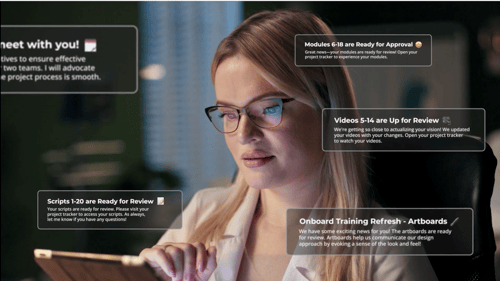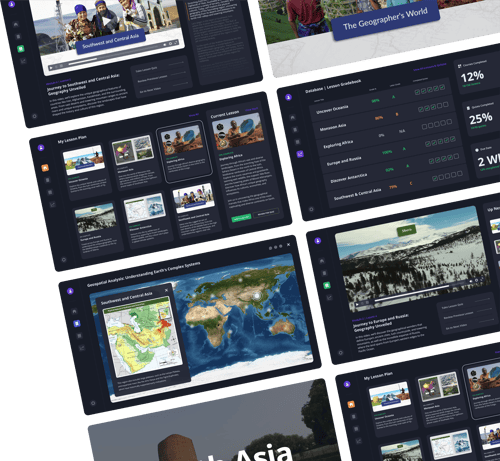Online education is undergoing a significant transformation in terms of the delivery and consumption of information. Video has become essential in advancing the quality of online learning experiences, offering a range of benefits that enhance the overall education journey. By using ELEVATE, we can explore 7 key ways in which video improves online courses:
-
E: Enhances Engagement
-
L: Lightens the Load
-
E: Encourages Flexibility
-
V: Values Personalization
-
A: Amplifies Accessibility
-
T: Transforms Instruction
-
E: Embraces Expertise
1. Enhances Engagement
Have you ever pulled out your phone in the middle of a boring PowerPoint presentation? How many times have you reread a sentence in a textbook because the content was so dull? Maybe you’ve daydreamed about vacationing on a tropical island during a lengthy lecture. Course videos contribute to a more dynamic and visually exciting learning experience compared to the traditional setup of online courses. Video can present complex information in a format that is easier to understand and apply, ultimately leading to deeper learner engagement. In the example below, the physical effects of anger were conveyed through a combination of graphics, animation, and narration instead of a bulleted list. The visual aids offered a memorable presentation that encouraged learners to better connect with the concept.
Instructors can also use different types of videos to demonstrate practical skills, show real-life examples, and give context to theoretical concepts. This can make the material more interesting and engaging for learners, helping them to understand and retain the information more effectively.
2. Lightens the Load
Imagine this: you open your textbook to the first page of the chapter. There is nothing but black text for several pages with the occasional diagram sprinkled in. You feel your eyes immediately glaze over and it takes you over 3 hours to read 10 pages. You still have 20 more pages left in the chapter.
Watching video content can lighten the overall cognitive load by breaking up large pieces of information into digestible chunks. For example, videos can provide visual aids, such as diagrams or animations, to help learners understand complex concepts. The visual aid below depicted Personal Protective Equipment (PPE) purpose and usage. A video walkthrough offered a refreshing alternative to the conventional image and text description of PPE gear and in the end, made the information easier to remember.
Video has the capability to increase information retention by creating meaningful and memorable learning experiences. Online courses can use video to break up long lectures and readings, allowing learners to focus on specific topics and take breaks without losing progress.
3. Encourages Flexibility
Are you constantly staring at the clock and calculating how minutes are left in class? Video-based learning provides flexibility to learners to access courses at their convenience, enabling them to fit their studies around their schedule. Learners can access video content from anywhere on their own time and can revisit the material multiple times. This is even true for live lectures thanks to features like screen recording, allowing instructors to record and edit video lectures that increase the effectiveness of their lectures.
A traditional classroom setting forces learners to adapt to a strict schedule and does not allow them to review the material as often as they need to. This is particularly helpful for learners who may have other commitments such as work or family. For instance, chunking a 3-hour long webinar into a series of 12-15-minute videos allows learners to watch one or two videos at a time rather than one painfully long session.
4. Values Personalization
Have you ever raised your hand in class and found that your teacher a) answered everyone’s questions except yours or b) ignored all questions in order to carry on? In a traditional classroom setting, instructors might not have the time or resources to offer individualized attention to each learner. With video, learners can move at their own pace, review material until they fully comprehend it, and take a break when they feel overwhelmed. Online courses that incorporate video promote active learning where students can pause, rewind, or fast-forward the video to reinforce concepts or to understand difficult topics better.
Or, imagine that you would like to help employees learn to navigate uncomfortable situations in the workplace. Provide a variety of realistic examples and create a video prompt that invites learners to practice the skill themselves.
5. Amplifies Accessibility
Turning on subtitles can be a great way to follow your favorite TV show’s story. Perhaps the dialogue is hard to understand during an action-packed scene, an actor has a thick accent, or you’re watching a foreign show. In any case, videos can use captions to make content more accessible to learners with different abilities and interests. Captions are particularly valuable for companies with global workforces or clientele as they open the door for sharing content in multiple languages.
People are different - in their preferences and how they learn. By using a variety of multimedia elements, videos can create a flexible and inclusive environment for diverse learners. Additionally, video content can support multiple learning styles. For example, practical demonstrations, interactive simulations, and virtual reality experiences help kinesthetic learners to grasp and apply concepts in a hands-on manner. Content that is more engaging and more fun is ultimately more impactful, which can lead to better learning outcomes.
6. Transforms Instruction
“Talking Heads” is better as a band than a content delivery method. A video that only shows a person speaking directly to the camera lacks visual interest and fails to capture the learner’s attention. Watching a person talk for extended periods of time can feel monotonous, boring, and repetitive. The lack of visual interest combined with a dry delivery can cause the learner to lose interest in the content.
Luckily, a “talking head” does not have to stand alone. Videos can employ multimedia, such as graphics and animations to explain complicated topics and add variety to the content. By incorporating multimedia, instructors can create courses that boost engagement, improve learning outcomes, and foster an impactful learning experience.
| RELATED: Reimagining e-learning: 7 Tips to Increase Engagement |
7. Embraces Expertise
Subject Matter Experts (SMEs) can bring credibility and relevance to your online courses, giving learners the knowledge they need to succeed. Videos allow the best SMEs to deliver their magic anytime, anywhere. Invest in a high-quality teacher and you’ll reap the benefits with all of your learners! SMEs can share their insights on emerging trends, new technology, and industry best practices to show students how the content can be applied in the real world. The rise of creators and influencers with millions of followers demonstrates how powerful the right teacher can be on video. It does take effort to find and manage the right SMEs for projects, but the results are worth it!
| RELATED: Effectively Managing Freelance SMEs: 7 Strategies for Success |
Using ELEVATE, we know 7 key ways that video enhances online courses. Video deepens engagement by presenting content in an interactive and easy-to-understand format. It can lighten the cognitive load by breaking up large pieces of information into manageable pieces. Video-based learning provides flexibility for learners to access the course content on their own time and offers personalized learning experiences. Video amplifies accessibility by making courses accessible to various learning styles and needs. Video’s use of multimedia elements, such as graphics and animations, can drastically enhance learner engagement. Lastly, video can leverage SMEs to provide accurate, high-quality, and relevant content that enhances credibility and gives students the knowledge they need to succeed.
Give Your Students More with NextThought Studios
Wish there was a professional, state-of-the-art studio to create videos for your online courses? Well, there is! NextThought Studios is an award-winning video production studio known for our affordable and engaging video creation services. We cover the entire process of pre-production to the actual shoot to editing videos for premiere. If you want to get more out of your educational offerings, we’re the studio for you.

NextThought team
NextThought transforms workplace learning through creative technology and engaging media. We're fortunate to partner with some of the top organizations in the world to make their educational training content remarkable and effective.
Recent Posts

What Can Go Wrong With A Custom Training Project? (And How NextThought Makes It Go Right)
August 5, 2025 1 Min Read

How Much Does a Custom Content Development Project Cost?
July 9, 2025 3 Min Read

The 6 Best Educational Video Production Companies (2025)
February 28, 2025 9 Min Read

